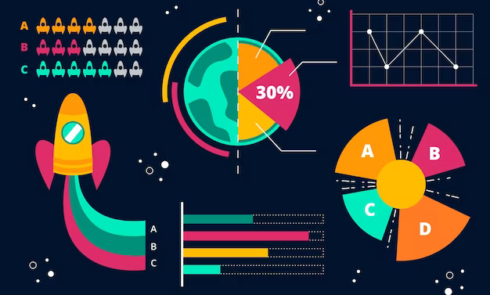The internet provides an incredibly fertile ground for storytelling, offering a plethora of creative avenues. Utilizing animations, illustrations, audio-visual elements, infographics, diverse typography, and other innovative tools, storytellers can weave intricate narratives that transcend conventional formats of mere text and images. These dynamic techniques not only enhance the visual appeal but also effectively captivate and immerse readers, making them particularly well-suited for presenting extensive content.
Beyond traditional media outlets, various brand marketing strategies are now delving into the realm of premium editorial content. Opting for deliberately “slow” narratives amidst the fast-paced digital landscape, they prioritize crafting experiences tailored for human engagement rather than algorithmic metrics. Our curated collection showcases a range of editorial websites that exemplify the potency of long-form storytelling in the digital domain.
Creative Design Techniques for Editorial Websites
When it comes to crafting compelling long-form content on editorial websites, the possibilities are endless. However, there are several tried and tested design styles and techniques that consistently captivate audiences. Let’s delve into some of the most popular ones:
Scrollytelling:
This technique involves text sliding over a fixed background image or video, creating a captivating cinematic experience for readers.
Tips:
- Use parallax scrolling to add depth and dimension to your scrollytelling narratives;
- Ensure smooth transitions between sections to maintain the flow of the story.
Example: National Geographic’s interactive articles often employ scrollytelling to immerse readers in breathtaking visual journeys.
Interactivity:
Micro-interactions, animations, dynamic scrolling, and sub-plots transform readers from passive observers to active participants in the narrative.
Recommendations:
- Incorporate interactive elements that prompt user engagement, such as quizzes, polls, or interactive timelines;
- Experiment with scroll-triggered animations to surprise and delight users as they navigate through your content.
Example: The New York Times’ feature stories frequently utilize interactive elements to enhance reader involvement and understanding.
Audio and Background Music:
Adding subtle audio elements and background music that complement visuals can elevate the overall sensory experience of web editorial content.
Best Practices:
- Choose ambient sounds or music tracks that enhance the mood and atmosphere of the storytelling;
- Allow users to control audio settings to cater to individual preferences.
Example: BBC’s digital features often integrate carefully curated soundscapes to evoke emotion and ambiance.
Infographics:
Data storytelling takes center stage with animated numbers, charts, and infographic elements that make complex information digestible and visually appealing.
Guidelines:
- Prioritize clarity and simplicity in infographic design to ensure easy comprehension;
- Utilize interactive charts and graphs to allow users to explore data further.
Example: The Guardian frequently utilizes infographics to provide readers with insightful visualizations that accompany their in-depth articles.
Decoding the Intricacies of the Venezuelan Refugee Crisis
The Venezuelan Refugee Crisis unveils the grim realities of Venezuelan citizens who have been forced to leave their homeland due to severe hyperinflation, scarcity of food and medicine, and political turmoil. This detailed analysis delves into the various elements that have resulted in this mass migration phenomenon.
Employing the versatile Vev design tool, the article uses delayed text and visuals to highlight the diverse facets of this humanitarian crisis. It includes movable text boxes over static images, interactive geographical depictions, and several other dynamic components assisting in better understanding of the crisis.
The crisis is a complex interplay of numerous factors and this scrollytelling-inspired design skillfully intertwines written content and visuals to simplify the understanding of the causes and consequences of this scenario. This article exemplifies how editorial websites can serve the larger interest and bring to light issues that might otherwise remain underrepresented.
Key Features:
- Time-delayed Text and Visuals: To emphasize different aspects of the crisis, the article uses delayed text and visuals. This technique adds depth and dimension to the narrative;
- Interactive Elements: With static images complemented by movable text boxes and interactive maps, the article offers a comprehensive and immersive exploration of the crisis;
- Scrollytelling Design: This engaging narrative style combines text and visuals in a seamless flow, enabling a more intuitive understanding of the complex crisis;
- Greater Good: By highlighting the Venezuelan refugee crisis, this piece demonstrates the influential role of editorial websites in drawing attention to critical global issues.
Examining the Venezuela Refugee Crisis: Unveiling the Humanitarian Tragedy Through Innovative Storytelling
The Venezuelan Refugee Crisis thrusts the dire circumstances of displaced Venezuelans into the spotlight. This grave predicament, rooted in hyperinflation, food scarcity, medical supply shortages, and political instability, has resulted in a massive exodus from the country, creating an unprecedented humanitarian crisis.
In an attempt to shed light on the various factors fuelling this crisis, this engaging narrative uses Vev’s design capabilities. The tool’s feature of time-delayed text and visuals provides an interactive deep dive into different facets of the crisis. Each element of the story – from moving text boxes over static images to interactive maps – serves as a guide, aiding the reader in comprehending this complex situation.
The crisis is an intricate web of various factors, but this scrollytelling technique simplifies the narrative by weaving together text and visuals. This unique approach to telling the Venezuelan story exemplifies the vital role that editorial websites play in amplifying underrepresented global issues.
Zero: Innovatively Highlighting the Imperative to Reduce Carbon Emissions
Zero makes a compelling case for the urgent need to reduce carbon dioxide emissions to combat the escalating global climate change crisis. This innovative presentation, built with Vev, utilizes multiple elements of scrollytelling to effectively communicate the importance of carbon reduction. With quotes and facts revealed over immersive background images and video embeds, it provides a meaningful and engaging user experience.
Wide-angle shots and detailed text explanations articulate the dire consequences of unchecked carbon emissions. By highlighting potential solutions to this pressing issue, the narrative succeeds in encouraging proactive steps toward a more sustainable future.
A Trail Tale: Transforming Travel Blogging with Interactive Storytelling
‘A Trail Tale’, executed using the Unity gaming engine, offers a fresh perspective on travel blogging. The interactive narrative depicts the true story of Andy’s expedition along the Appalachian trail.
Instead of typical blog entries, users witness Andy’s journey unfold as he walks through immersive woodland environments. Interactive icons hover over the character, sharing observations and experiences from the trek – a click unveils a new part of Andy’s adventure.
This inventive, game-infused narrative engages users on a whole new level, drawing them into Andy’s experiences on the Appalachian Trail. This pioneering concept not only makes for an exciting read but paves the way for future travel blogging trends.
The Empathy Experiment: A Journey into Emotional Intelligence
Empathy is an essential quality, and its absence often leads to misunderstandings and hurt feelings. The Empathy Experiment advocates for increased empathy through an innovative interactive approach. The narrative begins with a simple scenario – a joke cracked by a coworker that results in discomfort for another individual. Users encounter three different choices on addressing this situation, each leading to a diverse outcome.
The ingenuity of this project lies in its approach to teaching empathy through immersive gameplay, a method that transcends the efficacy of traditional mediums like blogs and videos. The Empathy Experiment creates a compelling and aesthetically pleasing user experience, demonstrating the value of understanding and recognizing others’ emotions and perspectives.
Garbage: A Thought-Provoking Exploration of Waste Impact
The project named “Garbage” seeks to catalyze a thought shift about the items we routinely discard. With its unique blend of hand-drawn illustrations, contrasting text sizes, and a dramatic color scheme of red, black, and white, it nudges us to reconsider our waste habits.
Garbage masterfully blends art and science to foreground the environmental implications of trash. Using a contemporary and stylized layout, it incorporates statistics, infographics, and detailed content to craft a comprehensive narrative around waste management. This initiative illustrates how editorial websites can address grave topics innovatively, educating readers through a blend of information and creativity.
Project Lima: A Vibrant Celebration of Neurodiversity
Project Lima is an exemplar of how digital media can be harnessed to foster a deeper understanding of complex topics – in this case, neurodiversity. The project’s mission is to demystify what it means to be neurodivergent, highlighting and celebrating the unique perspectives that these individuals bring.

Through the use of striking illustrations, engaging animations, calming electronic melodies, and insightful text, Project Lima presents readers with a multi-sensory exploration of the neurodivergent mind. The end goal is to cultivate empathy for neurodivergent individuals, and to underscore the importance of embracing diversity of thought.
Project Lima stands as a testament to how sensory-rich and delicately-crafted editorial content can not only educate but also foster empathy and understanding, thereby serving a higher purpose.
Climate Risk Innovation: A Clear-eyed Examination of Corporate Climate Challenges
From The Economist comes the Climate Risk Innovation website, a digital platform dedicated to analyzing the potential challenges businesses may face in light of global climate change. This editorial website exemplifies the potency of simplicity and clarity in conveying complex information.
Leveraging Vev’s smart layout features, the website employs guides and grids to structure its content meticulously. Reusable content blocks help segregate different types of content, ensuring a seamless browsing experience for the reader.
The platform’s strength lies in its direct approach to unpacking information. It distills the potentially overwhelming topic of corporate climate risk into digestible chunks, resulting in highly effective communication. This strategy is particularly beneficial for readers seeking quick access to valuable insights about business risks associated with climate change.
Exploring Linear Frameworks with Grids
Created as a testament to the aesthetic and functional possibilities of grids in web design, the Web project ‘Grids’ is an innovative creation by the Obys agency. The project delves into the elegance and utility of various linear frameworks, showcasing four distinct styles: column, Vandergraff, rectangular, and more.
Exhibiting a pronounced geometric essence, the site utilizes horizontal scrolling sections, animated blocks, and interactive scroll-triggered effects to illustrate the versatile uses of grids in web design. Obys brilliantly exemplifies the “show, don’t tell” principle, utilizing visuals effectively to communicate complex design concepts.
This project is a clear demonstration of not only Obys’ expertise in working with grids but also a masterclass in how editorial websites can leverage visuals to convey ideas and information.
WWF’s Initiative: Unveiling Canada’s Carbon Landscape
In a bid to educate the public about the crucial role of natural carbon reserves in mitigating climate change, the World Wildlife Foundation (WWF) has crafted an insightful editorial website. ‘Mapping Canada’s Carbon Landscape’ provides an in-depth view of the carbon stored in Canada’s ecosystems, soil, and other biomass.
Built using Vev, the layout is populated with text, maps, diagrams, and statistics, making the data-rich content more accessible and engaging. A complex topic that could have been presented as a dense white paper is instead transformed into a visually appealing, easily digestible digital experience.
Through its creative web design, WWF has succeeded in making this significant environmental information accessible to a wider audience, effectively making the complexities of carbon storage and its environmental impacts comprehensible to those without a scientific background.
Conclusion
In conclusion, the boundless creativity afforded by the internet allows storytellers to transcend traditional boundaries and craft immersive narratives through a variety of multimedia elements. Whether for media publishers or brand marketing strategies, the power of long-form storytelling on the web lies in its ability to capture and engage audiences on a deeper level. By embracing these innovative approaches, we can continue to push the boundaries of digital storytelling and create meaningful experiences for readers in the ever-evolving online landscape.

